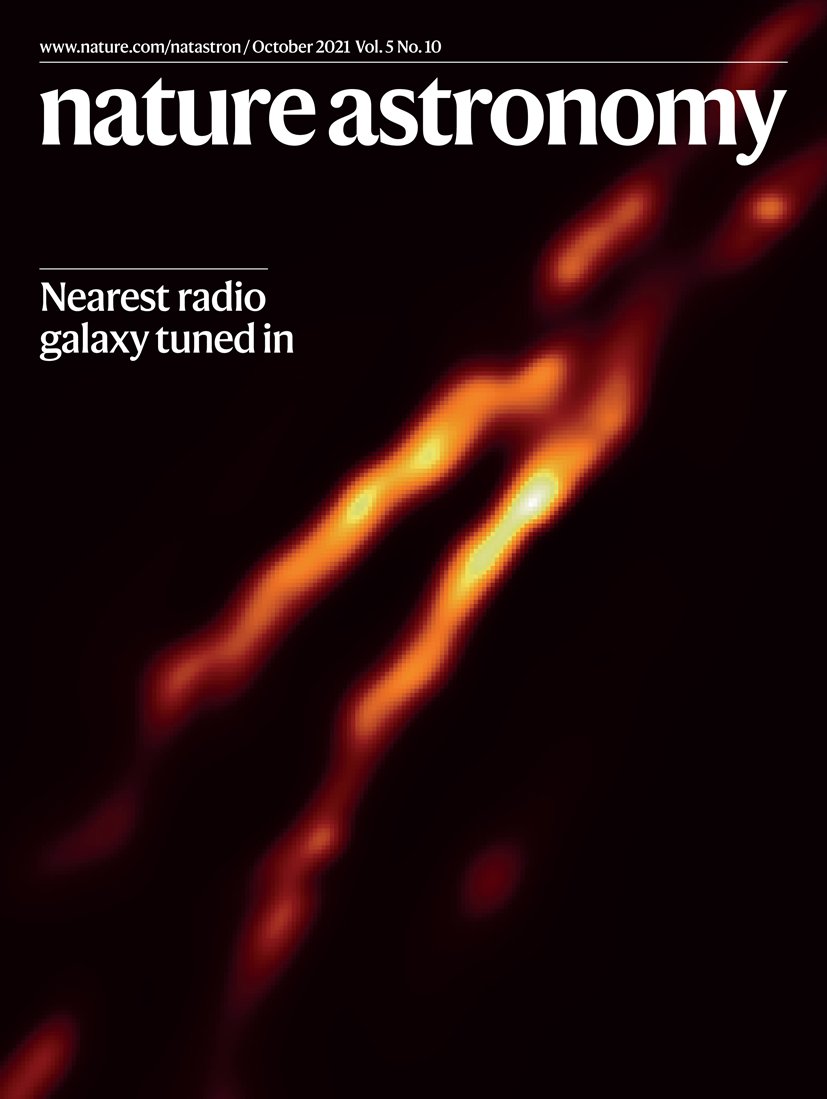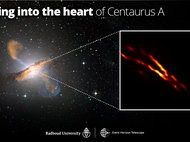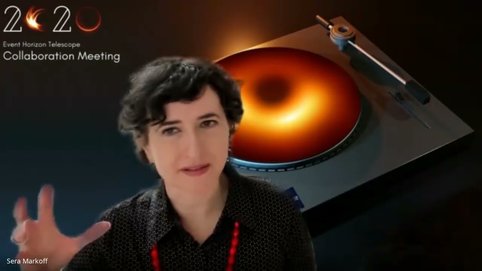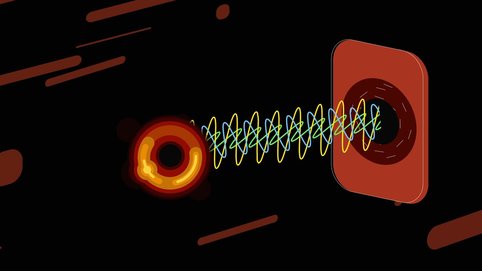Research Highlights
Here we show recent research results from the Radio Astronomy/Very-Long-Baseline Interferometry department.
Computing polarised jet emission
15 December 2021
A publication presented by Joana A. Kramer, PhD candidate at the MPIfR together with her supervisor, Nicholas R. Macdonald, shows that jet emission is edge-brightened when the magnetic field is toroidal in nature and spine-brightened when the magnetic field is poloidal in nature. Additionally, the circularly polarized emission exhibits both negative and positive sign for the toroidal magnetic field morphology. Last but not least, the relativistic jet's emission is largely independent of different emission scaling relations when the ambient medium is excluded. This is based in numerical simulations performed in 3D including relativistic, magnetohydrodynamic effects (PLUTO code), and synthetic images created from these virtual jets (using the RADMC-3D code, which can reproduce the polarised emission of light coming from its energetic, black-hole-powered plasma. More details are available in the present issue of Astronomy & Astrophysics, at this publication.
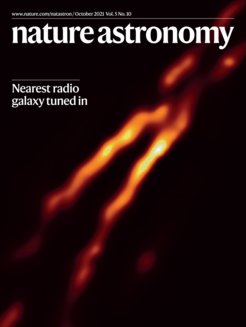
Press release by the Max Planck Society headquarters: Zoom into the dark heart of Centaurus A
The Event Horizon Telescope takes a close-up of the nearest radio galaxy
EHT Pinpoints Dark Heart of the Nearest Radio Galaxy, Event Horizon Telescope
EHT Collaboration Press Release on 19 July 2021
Press echo
English
A deep look at a nearby galaxy's black hole reveals the launching point of intergalactic jets, Phil Plait, Bad Astronomy blog at SyFy Wire, 19 July 2021
The amazing Event Horizon Telescope has done it again: It has taken extraordinarily high-resolution images of the nearby galaxy Centaurus A, revealing twin beams of material shooting away from the supermassive black hole in its heart at a significant fraction of the speed of light.
Event Horizon Telescope captures ‘beautiful’ images of second black hole’s jet, Daniel Clery, Science Magazine, 19 July 2021, quoting Michael Janssen
The astronomy team that 2 years ago captured the first close-up of a giant black hole, lurking at the center of the galaxy Messier 87 (M87), has now zoomed in on a second, somewhat smaller giant in the nearby active galaxy Centaurus A. The Event Horizon Telescope’s (EHT’s) latest image should help resolve questions about how such galactic centers funnel huge amounts of matter into powerful beams and fire them thousands of light-years into space. Together the images also support theorists’ belief that all black holes operate the same way, despite huge variations in their masses.
Event Horizon Telescope Reveals Curious Jet Structure from Black Hole, Camille M. Carlisle, Sky & Telescope, 20 July 2021, quoting Michael Janssen
Observations of the nearest radio galaxy, Centaurus A, provide the highest-resolution look at the long jets shooting from the galaxy’s supermassive black hole.
After capturing first photo of a black hole, Event Horizon Telescope zooms in on a second (Jackson Ryan), c|net, 20 July 2021, quoting Michael Janssen
From the telescope that brought you hits like The First Black Hole Photo comes the best look yet at extreme cosmic jets.
German:
Der Jet aus dem Herzen des Monsters, Franziska Konitzer, Spektrum, 19 July 2021
Schwarze Löcher verhalten sich ähnlich, Rainer Kayser, Welt der Physik, 19 July 2021, quoting Michael Janssen
In den Zentren der meisten Galaxien befindet sich ein Schwarzes Loch mit der millionen- oder gar milliardenfachen Masse unserer Sonne. Einen Blick in die unmittelbare Nähe dieser supermassereichen Objekte zu werfen, war lange nicht möglich. Erst mit dem Event Horizon Telescope, einem Zusammenschluss von Radioteleskopen in aller Welt, gelang die erste Aufnahme eines supermassereichen Schwarzen Lochs. Nun richteten Astronomen den Fokus auf das Zentrum der 13 Millionen Lichtjahre entfernten Radiogalaxie Centaurus A. Die Beobachtungen legen nahe, berichtet das Team jetzt im Fachblatt „Nature Astronomy“, dass sich Schwarze Löcher über einen weiten Massenbereich ähnlich verhalten.
Spanish:
El corazón de la galaxia Centaurus A observado con un detalle sin precedentes, Agencia Efe, 19 July 2021
La galaxia Centaurus A ha sido estudiada con un detalle sin precedentes por el Telescopio Horizonte de Sucesos (EHT), lo que ha permitido ubicar el agujero negro supermasivo que hay en su centro y detectar que de él está surgiendo un chorro gigantesco.
Un estudio que publica hoy Nature Astronomy y firmado por un equipo internacional, destaca que lo más sorprendente de las observaciones es que los bordes exteriores de chorro parecen emitir radiación, lo que desafía los modelos teóricos sobre este tipo de fenómenos.
EHT imaging of Centaurus A: A conversation with Nature Astronomy and Michael Janssen (and also the MPIfR alumni Sera Markoff and Marios Karouzos)
The cosmic battery powers galaxy halo magnetic fields
20 May 2021
A publication by the MPIfR-affiliated astronomer Ioannis Myserlis and his colleague Ioannis Contopoulos (Athens) reveals, appeared today at the Astronomy & Astrophysics journal, postulates a universal mechanism to explain the magnetic fields in galactic halos. The author have studied thirty-five nearby edge-on spiral galaxies from the Extended Very Long Array Survey named Continuum HAlos in Nearby Galaxies – an EVLA Survey (CHANG-ES), and detected large-scale magnetic fields in sixteen of them. The authors used radio polarization data to create Faraday rotation measure maps for all galaxies in the sample and stack them with the aim of amplifying any underlying universal toroidal magnetic field pattern in the halo above and below the disk of the galaxy. The presented work discovered a large-scale magnetic field in the central region of the stacked galaxy profile, which is attributable to an axial electric current that universally outflows from the center, both above and below the plane of the disk. A similar symmetry-breaking has also been observed in astrophysical jets, but never before in galaxy halos. This is an indication that galaxy halo magnetic fields are probably not generated by pure magnetohydrodynamic processes in the central regions of galaxies. One such promising physical mechanism is the Cosmic Battery operating in the innermost accretion disk around the central supermassive black hole. More details of this work can be found in the original publication here.
Einstein's Theory Can Explain the Black Hole M87*

20 May 2021
Event Horizon Telescope Collaboration scientists including MPIfR researchers use data which produced the first image of a black hole to constrain its fundamental properties.
In 2019, the EHT Collaboration published the first image of a black hole located at the centre of the galaxy M87. Now a collaboration team led by theoretical physicists at the Goethe University Frankfurt and with the participation of the MPIfR EHT team have analysed data from the black hole M87* to test Albert Einstein's theory of general relativity. According to the tests, the size of the shadow from M87* is in excellent agreement with a black hole predicted by general relativity, but narrows the properties of black holes in other theories down. These results are presented in today’s issue of the Physical Review D journal.
Constraining black hole models with EHT observations | Event Horizon Telescope
Einstein's Theory Can Explain the Black Hole M87*
X-ray studies from the binary black hole candidate OJ 287
05 May 2021
A new study of the quasar OJ 287, led by the MPI für Radioastronomie scientist Stefanie Komossa, presents results from spectroscopic observations performed between 2005 and 2020. In the long period of study, the galaxy nucleus presents extreme activity minima and outbursts. The X-ray spectrum of the source can be decomposed into three components: low-state emission consisting by Inverse Compton photons, super-soft synchrotron emission becoming dominant as the source brightens, and an additional outburst component with intermediately-soft photons. The publication discuss in detail the postulated black hole binary nature (having the primary black hole a mass of 18 billion solar masses) of the central region and the X-ray results. More details can be found at the original publication, presented at the latest issue of Monthly Notices of the Royal Astronomical Society.
Challenging the radio galaxy classification with the VLA-COSMOS survey at 10 cm wavelength
20 April 2021
An international team of astronomers led by Eleni Vardoulaki (affiliated to the MPI für Radioastronomie, at present at the Thüringer Landessternwarte in Tautenburg) has studied a sample of faint radio galaxies down to μJy levels with the 15-GHz sample of the VLA-COSMOS survey. Radio active galactic nuclei (AGN) are traditionally separated into two Fanaroff-Riley (FR) type classes, edge-brightened FRII sources or edge-darkened FRI sources. This dichotomy is becoming too simplistic in linking the radio structure to the physical properties of radio AGN, their hosts, and their environment. The work by Vardoulaki and collaborators approached the study of these galaxies both measured by a machine-learning algorithm and also by hand, following a parametric approach to the FR classification. Different physical parameters were estimated, as well as the galaxy host properties. The work shows a broad distribution and overlap of Fanaroff-Riley radio galaxies and jet-less/compact radio active galactic nuclei populations. The results point to the need for a different classification scheme, that expands the classic classification by taking into consideration the physical properties of the objects rather than their projected radio structure which is frequency-, sensitivity- and resolution-dependent.
These results are presented in the last issue of the journal Astronomy & Astrophysics, see the original publication here.
RadioAstron reveals the complex structure in the jet of quasar 3C 345
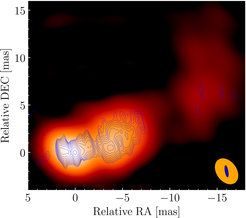
14 April 2021
A team of radio astronomers led by the MPIfR astrophysicist Felix M. Pötzl has studied the innermost jet morphology and magnetic field strength in the active galactic nucleus (AGN) 3C 345 with an unprecedented resolution using images obtained within the framework of the key science programme on AGN polarisation of the Space VLBI mission RadioAstron. The results analyze images obtained at a wavelength of 21 cm on 2016 March 30 with RadioAstron and eighteen ground-based radio telescopes. The obtained images reveal a complex jet structure a resolution corresponding to a projected linear scale of about 2 pc or a few thousand gravitational radii. This work identfies the synchrotron self-absorbed core at the jet base and find a brightest feature in the jet several parsecs downstream of the core. The work also studies the linearly polarised emission, which is related to the magnetic field distribution in the jet, and the intrinsic brightness of the source and its information about the source physics (via the so-called brightness temperature).
Additional information can be obtained at the original publication here.
Zoom Out of the Black Hole M87*
Beginning with the EHT’s now iconic image of M87, a new video takes viewers on a journey through the data from each telescope. Each step provides data across many factors of ten in scale, both of wavelengths of light and physical size.
A swing in the jet direction at the quasar 3C 273
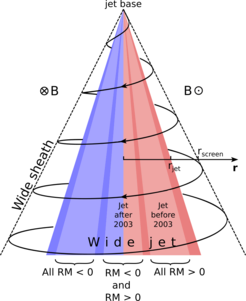
Sketch of a sheath wrapped around the wide jet in 3C 273. Subject to the single-epoch relativistic jet orientation, synchrotron emission of the jet passes through different parts of the sheath. Faraday rotation measures values change from positive to negative in 2003. If the jet turns southwards, only negative rotation measures.
24 March 2021
The high-redshift radio source with number 273 in the third Cambridge catalog (also known as 4C +02.32, ON 044, or CTA 053) is one of the best studied objects in very-long-baseline interferometry. New results presented in a publication led by the Bonn astronomer Misha Lisakov reveals changes in the polarisation of the jet which suggest a change in the jet direction during the period 2009-2010 from multi-wavelength studies using the Very Long Baseline Array. The work, presented in the latest issue of The Astrophysical Journal, shows that the jet Faraday rotation measure has changed significantly toward negative values compared with that previously observed. These changes could be explained by a swing of the parsec-scale jet direction, which causes synchrotron emission to pass through different portions of the Faraday screen. The work develops a model for the jet-sheath system in 3C 273 where the sheath is wider than the single-epoch narrow relativistic jet. The wide jet–sheath boundary is about 750 light years downstream from its beginning. Most of the Faraday rotation occurs within the innermost layers of the sheath. Further details on the jet parameters and the impact of this work in the study of other sources can be obtained in the original publication, see here.
Zoom into the Magnetized Black Hole M87* | Event Horizon Telescope
The Black Hole M87* Seen Through a Polarizer | Event Horizon Telescope
How Magnetic Fields Affect Black Hole Images | Event Horizon Telescope
Official EHT Press Release: Astronomers Image Magnetic Fields at the Edge of M87’s Black Hole (quoting, among others MPIfR alumnus Iván Martí-Vidal from the Univ. València)
The Event Horizon Telescope (EHT) collaboration, who produced the first ever image of a black hole, has revealed today a new view of the massive object at the centre of the M87 galaxy: how it looks in polarised light. This is the first time astronomers have been able to measure polarisation, a signature of magnetic fields, this close to the edge of a black hole. The observations are key to explaining how the M87 galaxy, located 55 million light-years away, is able to launch energetic jets from its core.
Media Echo
English
Astronomers detct strong magnetic fields around M87's black hole, Camille M. Carlisle, Sky & Telescope, 24 March 2021
Event Horizon Telescope data support the idea that magnetic fields control how black holes feed and grow.
Mysterious swirling light gives new insights into black holes, Linda Geddes, The Guardian, 24 March 2021
Scientists reveal first EVER photo of a supermassive black hole in polarised light: M87's galactic centre is caught on camera and could help to explain how the stellar phenomenon 'eats' matter, Ryan Morrison, Daily Mail, 24 March 2021
The supermassive black hole at the centre of the galaxy M87 is more than 6.5 billion times the mass of the sun. Astronomers used the Event Horizon Telescope to capture the sensational new images of the massive object. The black hole was the first to be directly imaged by astronomers and this new image is from the same data. The new image allowed the astornomers to measure polarisation from the light surrounding the black hole.
The Most Intimate Portrait Yet of a Black Hole, Dennis Overbye, The New York Times, 24 March 2021
Two years of analyzing the polarized light from a galaxy’s giant black hole has given scientists a glimpse at how quasars might arise.
Global telescope creates exquisite map of black hole’s swirling magnetic field, Alison Kiesman, Astronomy, 24 March 2021
The Event Horizon Telescope’s newest images of M87’s supermassive black hole hint at how its jets are fired far into space.
Magnetic Field around a Black Hole Mapped for the First Time, Stephanie Pappas, Scientific American, 24 March 2021
Images from the Event Horizon Telescope reveal new details of how supermassive black holes produce huge jets of matter and energy.
New picture of famous black hole reveals its swirling magnetic field, Leah Crane, New Scientist, 24 March 2021
The first picture of a black hole’s shadow just got even more interesting. The Event Horizon Telescope (EHT) collaboration released the first direct image of a black hole in 2019, and while the picture on its own was impressive, it wasn’t the scientific smorgasbord some had hoped for. Now, researchers have added polarised light to the picture, giving us an idea of how magnetic fields around a supermassive black hole create powerful jets of matter.
Event Horizon Telescope sees the Magnetic Engine behind a Supermassive Black Hole's Immense Power, Phil Plait, Bad Astronomy, 24 March 2021
In 2019, astronomers stunned the world, releasing an epic image of material swirling around the supermassive black hole in the core of the galaxy M87 55 million light years from Earth. They connected radio telescopes from around the planet to create the Event Horizon Telescope, a virtual telescope mimicking the power of a telescope the size of our planet, to achieve this amazing observation.
German
Schwarzes Loch: Warum ein Monster im All Materie ausspuckt, Johannes Magnus, Rhein-Zeitung, 31 March 2021, quoting J.A. Zensus
Acht riesige Radioteleskope beobachteten 2017 vier Tage lang gemeinsam ein Monster im All: das Schwarze Loch inmitten der fernen Galaxie M87. 55 Millionen Jahre lang waren die Licht- und Radiowellen von dort bis zur Erde gereist, wo sie eingefangen wurden. Die Daten der Teleskope wurden zwei Jahre lang mit Supercomputern zusammengerechnet und überprüft. Dann präsentierten die Astronomen der Menschheit das erste Bild eines Schwarzen Lochs. Nun haben sie den Daten weitere Einzelheiten entlockt und entdeckten gigantische Magnetfelder um den kosmischen Giganten.
Schwarzes Loch in der Galaxie M87: Forschende machen Magnetfelder sichtbar – „Schlüssel zum Verständnis“, Tanja Banner, Frankfurter Rundschau, 31 March 2021
Das erste schwarze Loch, das von Forschenden fotografiert wurde, sorgt erneut für Aufsehen: Ein Forschungsteam hat nun seine Magnetfelder untersucht.
Forscher machen Magnetfelder nah an Schwarzem Loch sichtbar, Wochenblatt.de, 30 March 2021, quoting J.A. Zensus
Das erste Bild eines schwarzen Lochs, das von Forschenden fotografiert wurde, sorgt bereits 2019 für Aufsehen: Nun haben die Experten seine Magnetfelder unter die Lupe genommen.
Erstmals Magnetfelder am Rand eines Schwarzen Lochs gemessen, Der Standard, 27 March 2021, quoting J.A. Zensus
Vor zwei Jahren konnte erstmals der Schatten eines Schwarzen Lochs fotografiert werden. Jetzt entdeckten Forscher dort polarisierte Radiostrahlung.
Schwarzes Loch in polarisiertem Licht, Welt der Physik, 24 March 2021
Am 10. April 2019 veröffentlichten Wissenschaftler das allererste Bild eines Schwarzen Lochs, das eine helle ringförmige Struktur mit einer dunklen zentralen Region – dem Schatten des Schwarzen Lochs – zeigt. Die zugrunde liegenden Daten, gesammelt mit dem Event Horizon Telescope, hat die Kollaboration seither noch eingehender untersucht. Ein signifikanter Anteil des Lichts um das supermassereiche Objekt im Zentrum der Galaxie M87 ist demnach polarisiert. Und das zeige deutlich, dass der Ring um das Schwarze Loch magnetisiert ist, berichtet das Team nun in zwei separaten Artikeln in der Fachzeitschrift „The Astrophysical Journal Letters“.
Erster Blick auf Magnetfelder am Schwarzen Loch, Nadja Podbregar, Wissenschaft.de, 24 March 2021
Im April 2019 sorgte das erste Foto eines Schwarzen Lochs für weltweites Aufsehen. Jetzt zeigt das Event Horizon Telescope (EHT) weitere Details des supermassereichen Schwarzen Lochs im Zentrum der Galaxie M87. Denn erstmals haben die Astronomen auch die Polarisation des Lichts gemessen, das direkt am Rand des Schwarzen Lochs frei wird. Diese Schwingungsrichtung des Lichts liefert wertvolle Informationen über die Magnetfelder im Umfeld eines solchen Schwerkraftgiganten und könnte erklären, wie es dieser aktive Galaxienkern schafft, extrem energiereiche Strahlen- und Materiejets zu erzeugen.
Aufnahme des Schwarzen Lochs von M87: Polarisiertes Licht verrät Magnetfelder, Martin Holland, heise.de, 24 March 2021
Die erste direkte Aufnahme des Ereignishorizonts eines Schwarzen Lochs enthält noch Überraschungen: Das Licht macht die Magnetfelder vor Ort sichtbar.
Magnetfelder im Vorhof der Hölle, Robert Gast, Spektrum der Wissenschaft, 24 March 2021
2019 blickte die Menschheit direkt in das Schwarze Loch im Herzen der Galaxie M87. Nun haben Forscher neue Details aus der weltberühmten Aufnahme herausgeholt.
Das Schwarze Loch offenbart neue Geheimnisse, Sibylle Anderl, Frankfurter Allgemeine Zeitung, 24 March 2021
2019 war es das eindrucksvollste Wissenschaftsbild: Die erste Aufnahme eines Schwarzen Lochs, aufgenommen mit einem erdumspannenden Teleskopverbund. Nun hat es ein Upgrade erhalten.
Auf der Spur der kosmischen Fackel, Jörg Römer, Der Spiegel, 24 March 2021
Forscher haben das erste Bild eines schwarzen Lochs neu ausgewertet. Dabei kamen sie dem Ursprung von mächtigen Plasmastrahlen so nah wie nie zuvor.
Forscher machen Magnetfelder nah an Schwarzem Loch sichtbar, Süddeutsche Zeitung (dpa), 24 March 2021, quoting J.A. Zensus
Vor rund zwei Jahren veröffentlichten Forscher zum ersten Mal das Bild eines Schwarzen Loches. Nun sind sie bei der genaueren Untersuchung des Schwerkraftmonsters in der weit entfernten Galaxie Messier 87 (M87) einen weiteren Schritt vorangekommen.
French
Le trou noir géant M87 commence à livrer ses secrets, Le Figaro, 25 March 2021
Le 10 avril 2019, une collaboration d'astronomes internationale avait montré le premier cliché d'un trou noir, au cœur de la galaxie M87.
Voici à quoi ressemble le champ magnétique au bord du trou noir M87*, Nelly Lesage, Numerama, 24 March 2021
La collaboration de l'Event Horizon Telescope a obtenu une nouvelle image importante du trou noir M87*. Elle est réalisée en lumière polarisée, ce qui offre un aperçu unique du champ magnétique aux abords du trou noir.
Spanish
Primera observación del campo magnético circundante a un agujero negro, Ignacio Crespo, La Razón, 25 March 2021
Haber obtenido una imagen del campo magnético de las inmediaciones de un agujero negro podría ayudar a entender los grandes chorros emitidos por este.
Observan por primera vez los campos magnéticos de un agujero negro, Rafael Ordóñez, El Independiente, 24 March 2021
El Telescopio del Horizonte de Sucesos (EHT), que produjo la primera imagen de un agujero negro, ha revelado hoy una nueva vista del objeto masivo en el centro de la galaxia Messier 87 (M87). Se trata de un nuevo hito en la observación astronómica al analizar, en luz polarizada, el agujero negro supermasivo.
Una nueva imagen permite observar por primera vez el 'borde' de un agujero negro, José Manuel Nieves, ABC, 24 March 2021
Es la primera vez que se consigue fotografiar el agujero negro M87 en luz polarizada, lo que permitirá comprender la naturaleza de los enormes chorros de energía que surgen del corazón de la galaxia.
Una nueva imagen de un agujero negro, Ernesto Lozano Tellechea, Investigación y Ciencia, 24 March 2021
La colaboración EHT obtiene las primeras imágenes en luz polarizada de un agujero negro. El hito permite reconstruir el campo magnético en las inmediaciones del objeto y aporta pistas clave para entender cómo se comporta la materia caliente que lo rodea.
Se observan los campos magnéticos en el borde del agujero negro de la galaxia M87, desQbre, 24 March 2021, quoting MPIfR alumnus Iván Martí-Vidal (Univ. València)
La colaboración del Telescopio del Horizonte de Sucesos (EHT por sus siglas en inglés), que produjo la primera imagen de un agujero negro, ha revelado hoy una nueva perspectiva del objeto masivo en el centro de la galaxia M87: cómo se ve en luz polarizada. Se trata de la primera vez que los astrónomos han podido medir polarización, la “firma” de los campos magnéticos, tan cerca del borde de un agujero negro. Las observaciones son clave para explicar cómo la galaxia M87, ubicada a 55 millones de años luz de distancia, puede lanzar chorros de material muy energéticos desde su núcleo.
A ring accelerator to produce neutrinos in a quasar jet?
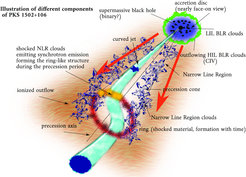
17 March 2021
An international team of radio astronomers led by Silke Britzen at the MPI für Radioastronomie suggests the connection between the high-energy neutrino production in the quasar PKS 1502+106 with remarkable features in the jet. Their analysis suggests a radio ring structure in the parsec-scale jet that develops with time. Several arc-structures evolve perpendicular to the jet ridge line. The work also finds hints for precession of a curved jet based on kinematic modelling and a periodicity analysis. The atypical ring may be connected to an interaction of the precessing jet with the outflowing material. Energetic neutrinos are most likely produced by proton–proton interaction in the blazar zone, enabled by episodic encounters of the jet with dense clouds, that is, with some molecular cloud in the outer part. These results have been published today for the May 2021 issue of the British journal Monthly Notices of the Royal Astronomical Society. For additional information, see here.
Collimating jets in radio galaxies: the case of NGC 315

11 March 2021
A study presented by a European team led by the MPIfR astronomer Bia Boccardi (head of an Otto Hahn Research Group) today in Astronomy and Astrophysics reveals a zoom in the structure of the powerful jets in this radio galaxy. The double jet in this galaxy shows a remarkable persistence in its direction at very different scales. The collimation, apparently, is already completed in the innermost region (parabolic shape) and is kept for scales much larger than the optical galaxy (conical shape).
The optical nebula hosting the powerful jet has the number 315 in the New General Catalogue (NGC 315). It is an elliptical galaxy in the constellation Pisces. It was discovered on September 11, 1784 by William Herschel. It is also known as HOLM 028A, OB +392, and TXS 0055+300.
Furthermore, Boccardi's work discusses the possibility that relativistic jets are collimated by winds originated by the accretion disk which surrounds the super massive black hole. The study suggests that a powerful external layer in the jets (sheath) stabilizes the inner spine by isolating it from the interstellar medium, so that the jet travels mostly unperturbed to reach the intergalactic medium. These considerations also play a role to define the different types of galaxy, classified as type I (luminosity decreases as the distance from the central galaxy or quasar host increase) or type II (increasing luminosity in the lobes) in 1974. The publication (open access) can be found here.
